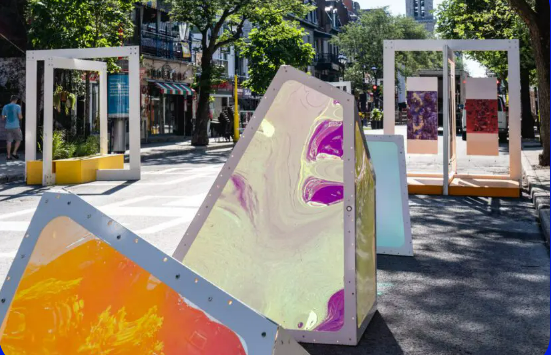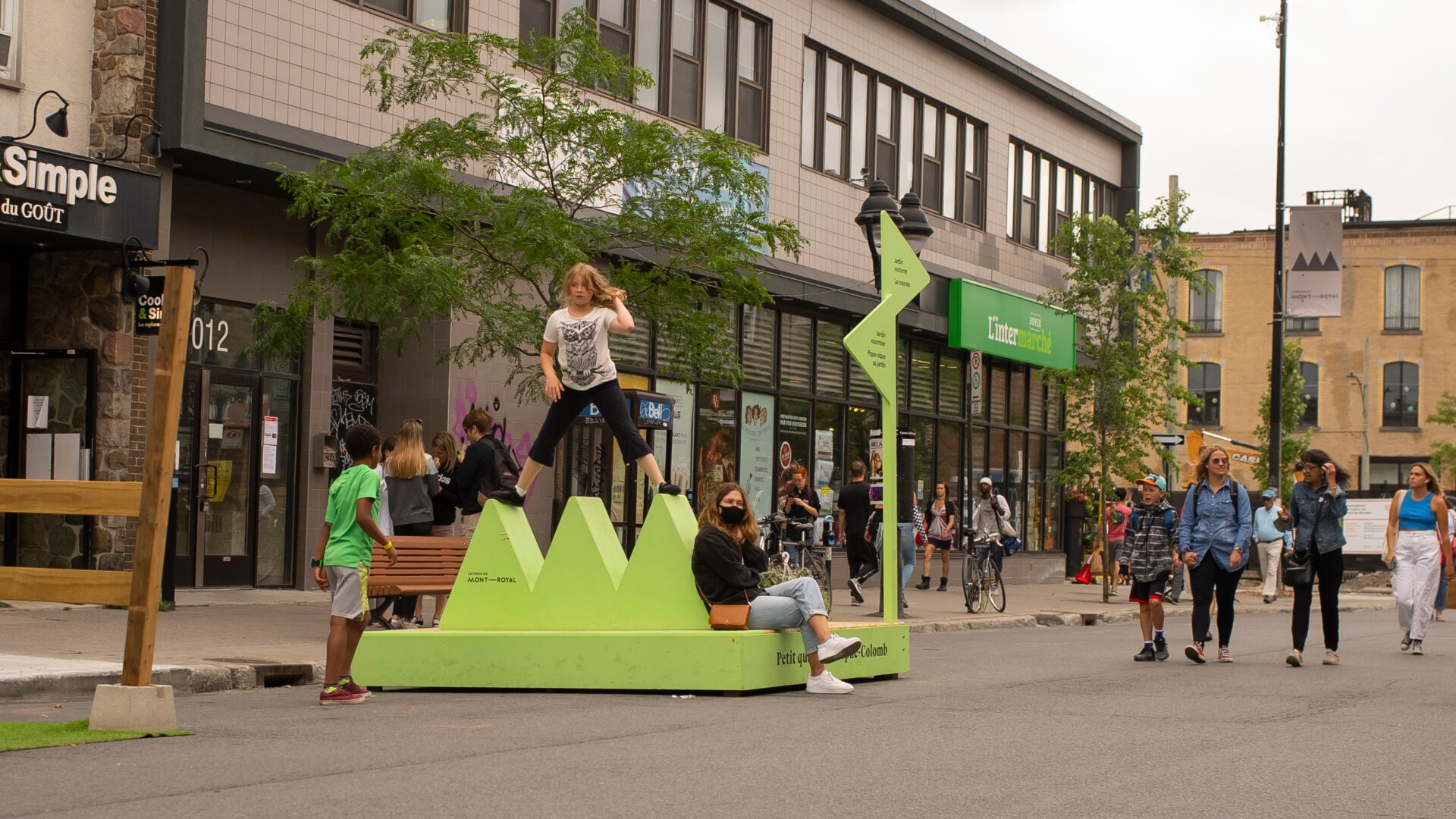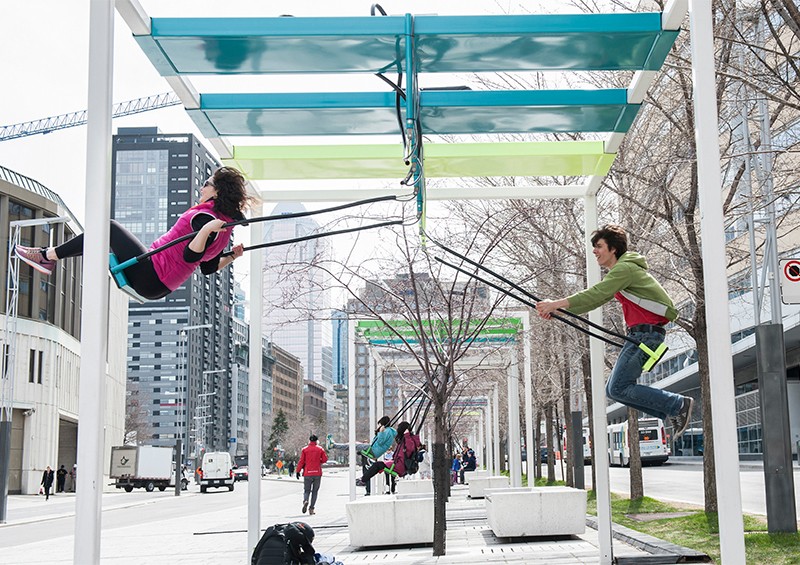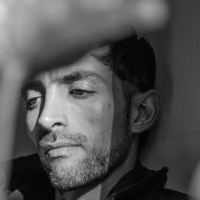christian scott is a queer mexican-canadian PhD student in Concordia University’s INDI program, researching playful urbanism. Their work explores critical placemaking, participatory urban design, and urban play as resistance. Alongside their doctorate, they direct Mutual Design, a small agency specializing in research, strategy and design for social impact, supporting nonprofits, Indigenous communities, and value-driven companies in communicating their campaigns. You can see more of their work here.
Playful Urbanism: Reimagining Community Planning in Montreal
by christian scott
 Pedestrian-friendly design in Montreal's Quartier Latin. Photo from Aire Commune: https://airecommune.com/en/projects/pedestrian-street-of-the-quartier-latin/
Pedestrian-friendly design in Montreal's Quartier Latin. Photo from Aire Commune: https://airecommune.com/en/projects/pedestrian-street-of-the-quartier-latin/
This piece was selected as part of SHIFT's special edition issue Shaping Our City (November 2025), which invited pieces from our community related to what it means to design a more equitable city.
Cities are never finished. They are dynamic, living systems shaped by everyday relationships, struggles, and negotiations over meaning and power. In Montreal, this is especially visible: a city layered with colonial histories, linguistic tensions, a housing crisis, and waves of migration, where debates over public space reflect deeper questions of belonging and justice.
Urban planning, in theory, is about serving the public good. In practice, it too often reflects the priorities of those with the most influence—developers, institutions, and municipal agendas—rather than the lived realities of the communities most affected by change. Placemaking, the process of collectively shaping public space, is often presented as an antidote: a way to make planning participatory and human-centered. Yet placemaking is never neutral. It can foster inclusion, creativity, and empowerment, but it can also erase and commodify. When “community engagement” becomes a checkbox exercise, participation risks becoming performance.
This tension raises the question at the heart of Montreal’s future: what would a more community-based, equitable, and imaginative form of city planning look like?
To truly serve our communities, higher education must shift from teaching planning as management to teaching it as relational practice: something that listens, adapts, and co-creates.
Community-based planning requires more than inviting residents to comment on pre-made proposals. It asks for processes where people can imagine, negotiate, and decide together what kind of city they want to inhabit. Montreal has seen inspiring examples—from citizen-led greening projects in Parc-Extension to neighborhood mobilizations against speculative development. But too often, these efforts occur despite institutional planning, not because of it.
To truly serve our communities, higher education must shift from teaching planning as management to teaching it as relational practice: something that listens, adapts, and co-creates. It must acknowledge that community knowledge—stories, rituals, and acts of everyday care—are as valuable as professional expertise and urban design software.
This is where play becomes not just a metaphor, but a method.
The Playable City: The Transformative Power of Play
Play in urban design can unsettle norms, surface hidden assumptions, and create conditions for collective imagination. This method invites us to see the familiar differently: a crosswalk becomes a stage, a vacant lot becomes a canvas, a conversation becomes a game of shared world-building.
The Playable City is a concept and an approach to urban design that uses creativity, fun, and imagination to invite people to interact with their surroundings—and with each other—in unexpected ways. It transforms infrastructure into a medium for connection: a bench that tells a story, a lamppost that reacts to movement, a projection that reveals hidden histories.
In Montreal, a city already rich in cultural experimentation and civic play, the idea of a Playable City resonates strongly. It offers ways to turn ordinary streets into spaces of encounter, to build empathy through shared experiences, and to connect with strangers. Yet this potential depends on process: who defines the play, and for whom? When play emerges from within communities—reflecting their stories, humor, and struggles—it becomes a form of urban dialogue. When imposed from above, it risks turning joy into branding, fun into an experience with a price tag. A truly playable Montreal would treat play not as spectacle, but as a tool for collective reflection, care, and belonging.
 Photo of pedestrian-friendly infrastructure on rue Mont-Royal. Photo from INT Design: https://int.design/en/projects/pietonnisation-de-lavenue-du-mont-royal/
Photo of pedestrian-friendly infrastructure on rue Mont-Royal. Photo from INT Design: https://int.design/en/projects/pietonnisation-de-lavenue-du-mont-royal/
Play as a Tool of Participation
As a participatory design tool—or more broadly, as a form of playful urbanism—play offers a way to break down hierarchies and invite creativity. Workshops that incorporate games, role-play, or storytelling let participants explore complex trade-offs—between housing and green space, growth and heritage, or access and safety. These methods create space for uncertainty and imagination, two qualities often absent from traditional planning approaches.
Play shifts participation from procedural to transformative. Rather than asking residents to respond to predefined plans, it invites them to imagine new possibilities. In Montreal—a city with a diverse ecosystem of design agencies, collectives, non-profits, and a relatively progressive public service—play has been and continues to be used as a method to engage citizens and co-create urban futures. In other words, designing the city can be a shared, creative act that values curiosity as much as expertise.
Yet not all play is liberatory. Games can reproduce the same social hierarchies they claim to disrupt. Digital installations may exclude those without access to technology; competitive activities may privilege dominant cultural norms. Play can even be co-opted by neoliberal urban agendas, used to brand the city as “innovative” while ignoring issues of affordability and displacement.
For playful urbanism to be equitable, designers and planners must approach play critically. This means centering marginalized voices, building long-term relationships with communities, and being transparent about intentions and outcomes. It also means acknowledging that not everyone experiences play in the same way—safety, accessibility, and cultural sensitivity must be integral parts of design.
Toward Playful Futures
Playful urbanism reimagines the city as a living playground—a site of creative and shared world-making. It rejects the notion of cities as systems to be optimized and instead frames them as collective experiments in coexistence.
In Montreal, this could mean integrating playful methods into community planning, design education, and municipal policy. Universities could host speculative “city games” where students and residents collaboratively imagine responses to housing crises or climate adaptation. Planners could use participatory storytelling to reveal how zoning affects lived experience. Artists could partner with neighborhoods to transform everyday infrastructure into invitations to care and connect.
 Photo of Montreal's Musical Swings at Place-des-Arts. Photo from UQAM: https://actualites.uqam.ca/2016/21-balancoires-au-quartier-des-spectacles/
Photo of Montreal's Musical Swings at Place-des-Arts. Photo from UQAM: https://actualites.uqam.ca/2016/21-balancoires-au-quartier-des-spectacles/
However, this is not a matter of future times; play is already being implemented in various ways by diverse urban stakeholders. The most obvious and contemporary example is perhaps 21 Balançoires (21 Swings) by public space art and design studio Daily Tous Les Jours. Since 2011 a series of swings in the intersection of Quartier des Spectacles / UQAM have created the perfect excuse for urbanites to have fun, and to create music and experience joy with total strangers. As swings move together, musical notes and melodies create compositions in which each swing plays a different instrument.
The swings represent the kind of playful intervention that momentarily creates a space and time where the logics of capitalist urban living hold no power; one in which strangers can together create something ephemeral and unmeasurable—for the sake of having fun.
By treating city-making as a shared, playful process, Montreal can build urban spaces that are not only functional and sustainable, but also equitable, vibrant, and alive with possibility.
Conclusion
As cities worldwide face crises of affordability, xenophobia and discrimination, and ecological collapse, Montreal stands at a crossroads. Its creative energy and civic spirit position it uniquely to lead experiments in more caring and imaginative forms of urban life.
Playful urbanism is not a luxury; it is a necessity for re-enchanting participation and renewing trust in collective futures. It reminds us that even in moments of precarity, joy and imagination are forms of resistance. By treating city-making as a shared, playful process, Montreal can build urban spaces that are not only functional and sustainable, but also equitable, vibrant, and alive with possibility.



